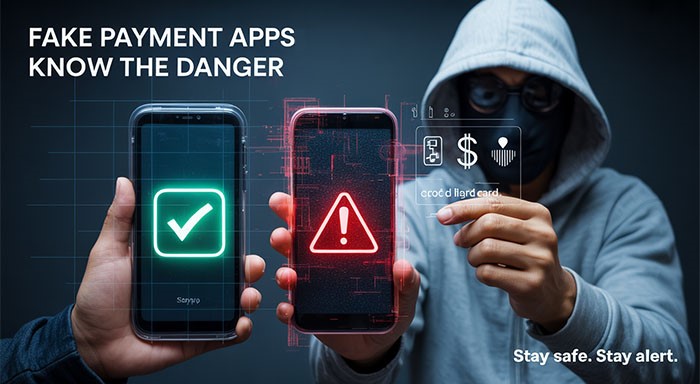This digital era has simplified the payment process to a few simple steps, making online transactions more convenient than ever. From UPI apps to online wallets, there are plenty of popular payment options available. Among them, various prank applications are also gaining traction, like fake payment apps. These deceptive platforms mimic the same user interface, design, color scheme, and often the entire payment process of genuine payment apps. With actual notification sounds and payment details, it becomes hard for people to distinguish between real and fake transactions.
This is how people used this platform for making pranks on friends with fake payment screenshots and fake bank statements. Meanwhile, many individuals may misuse these platforms for illegitimate purposes, like fraud, scams, and deception. Whether you’re a business owner, shopkeeper, or someone else, staying aware of these fraudulent apps can minimize the risk of losing money.
This blog is all about understanding what these fake payments are, how they work, potential risks, and best practices to stay safe. Stay tuned with this blog to get a detailed view of this prank but fake payment application.
What Exactly are Fake Payment Apps?
At their core, these mobile applications are designed to mimic real digital payment platforms, but they are actually fake. Primarily, these platforms are created for fun purposes like pranks, but most people use them to trick other people through fake online payments. As it imitates the actual UI for popular payment apps like PayPal, Paytm, BHIM UPI, and Google Pay, it is easy for scammers to fool other people or merchants. Here, users can generate fake payment receipts by choosing the desired amount and payment apps where they want to make payment. The appearance of fake payment apps looks similar to the actual payment receipts, confusing people to identify fake payment receipts.
While some applications are dedicatedly designed only for fun and enjoyment through pranking or teasing friends and family. These platforms don’t show real banking or UPI services and encourage users to maintain ethical considerations while using the platform.
Key Features Offered by Fake Payment Apps
- Realistic User Interface: The interface of these platforms often looks like real, legitimate platforms. From platform logo to font, color, and payment details, all are designed in a way that is difficult to disguise at first glance. While its simple, user-friendly interface makes it perfect for both fun, as well as illegitimate purposes alike.
- Free to Use: These kinds of platforms don’t ask you for any payment to create fake receipts. Users can generate unlimited amounts of bank receipts and fake payment screenshots completely free of cost. This encourages individuals to utilise the platform for making fun and pranks with others.
- Fake Payment Notification: Some applications simulate fake payment notification sounds to inform the opponent party that payment is made. This feature creates the illusion of an actual transaction for individuals, ensuring their payment is taken.
- Offline Accessibility: These platforms can operate without an Internet connection, making them easily accessible to a wide range of users. As they only generate fake payment screenshots instead of actual payments.
Best Practices to Stay Safe from Fake Payment Apps
Want to stay protected from such applications? Basically, these frauds take place when fraudsters show fake payment receipts to convince people that the transaction is completed. Meanwhile, they utilize fake payment apps to generate counterfeit receipts. But keeping some key tactics in mind can help prevent these fraudulent activities.
1. In such a case, first check your own UPI app or bank account to verify the transaction. Do not entirely depend on notification sounds and payment screenshots.
2. If you don’t have time to look at the bank account, thoroughly verify the transaction details. Fake payment applications often generate receipts with minor inconsistencies that can be a sign of a scam.
3. Always trust reliable and commonly used payment platforms, take precautions against unknown apps. Educate yourself and your staff about legitimate or fake payment apps that help you stay ahead of such payment frauds.
4. One such post-fraud tactic is to instantly report unusual or suspicious activity to police or the cybercrime department. This can be a great preventive step if you encounter this activity during or after completing the payment process.
5. Importantly, innocent victims need to report to the actual website about such activity through its real UPI app, customer care number, or cyber cell.
For additional protection, businesses can also leverage tools like sanctions screening software to flag suspicious transactions or users, especially in cases involving cross-border or high-risk payments.
How to Identify a Fake Payment Apps
Not sure if the application is fake or trustworthy? Consider these tips and tricks to determine the real payment application. Here they are as follows:
- Look for inconsistencies: These apps usually generate low-quality screenshots, have grammar mistakes, and ask you for unusual permissions. Always verify developers and brand names through their website and social media to evaluate the platform's legitimacy.
- Check Reviews and Ratings: Before making a final decision, always check the platform’s reviews and ratings. Because legitimate apps often have high ratings and positive reviews, while fake payment apps have low and suspicious ratings and reviews.
- Download Count and Release Date: Individuals can evaluate platform legitimacy through its download counts and release date. Fake apps have low downloads and recent release dates, while reliable platforms are more established and make significant strides in ensuring safety.
- Permission Request: If the payment platform asks you for excessive and unsolicited payment requests, this can be an unreliable payment app. However, trustworthy platforms ask permission only related to their core functionality.
- Download Apps from Trusted Sources: To ensure downloading secure, genuine platforms, you may need to use trusted sources like Play Store or Apple Store. These sources have robust security policies that help prevent the listing of illegitimate platforms that can hinder user security.
Conclusion
In the rapidly evolving world of today, fake payment apps are becoming the most concerning threat in the digital transaction space. While the platform was initially designed for fun and entertainment purposes, most people used this for wrong and unauthorised purposes. Most individuals generate fake receipts only with pure intention, using them for harmless pranks on friends and family.
The increasing rise of digital payment worldwide grows the concern of cyberthreats, frauds, and scams simultaneously. These fake payment apps are one of the major causes of cyber risks. However, staying informed about the potential risks and preventive measures associated with this application is essential to protect you and your business. Irrespective of whether you are a street vendor, merchant, or business owner, verifying the authenticity of each transaction is more crucial than ever. A significant lack of this can harm your hard-earned reputation, cause financial losses, and create potential legal obligations.



